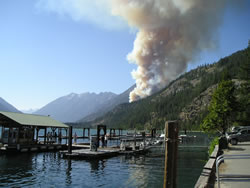
National Fire Plan Success Story
Hazard Fuel Reduction Treatments Prove Effective
Lake Chelan National Recreation Area, Washington
National Fire Plan - Fuels Reduction
2010

Rainbow Bridge Fire soon after discovery on July 29, 2010. Photo by Bill Fitzpatrick, NPS.
Residents of and visitors to Stehekin, Washington saw an alarming sight when the Rainbow Bridge Fire, located just ½ mile from this remote community, was discovered at 4:45 pm on July 29, 2010. This lightning caused fire quickly grew from a few acres to several hundred acres and was highly visible for miles. The fire was located in extremely steep terrain, so the only option for response by community members and firefighters was defense from the valley bottom with objectives being to protect life and property (homes, historic structures, businesses, and community infrastructure).
Quick response and cooperative efforts over the next 24-48 hours by Fire District 10 volunteers, National Park Service staff, North Cascades Smokejumpers, individual community members, and Washington State Incident Management Team 3 subdued immediate threats of the fire overtaking Stehekin. A few days later Mother Nature, in the form of rain, helped with the rest. Continued vigilance by firefighters with use of aerial resources for the rest of fire season arrested any additional fire growth towards the community.
Fortunately, National Fire Plan dollars have helped fund an active fuel reduction program, which was key to initial attack success. There were completed treatment areas to launch safely defensive tactics such as burnout operations, hoselay/sprinkler deployment, and fireline construction. Around some structures, old prescribed burn firelines were simply refreshed. Because of thinning and prescribed burning to create fuelbreaks and actions by firefighters to utilize these areas, no structures were lost and no injuries occurred.
These ongoing fuel treatment efforts started in 1990. If the same fire had occurred 15 years ago, the outcome would have been profoundly different. National Park Service personnel have treated over 2,500 acres through mechanical and prescribed fire use. Individual homeowners, through encouragement of Fire District 10 Staff, have completed extensive defensible space projects throughout the community. Much of this has been done by conducting “work parties” as part of FD 10 meeting/training nights. All accomplishments have been cooperative in nature with interagency partners and community support.
Rainbow Bridge Initial Attack Incident Commander and North Cascades Smokejumper, Inaki Baraibar sums it up well, “All the preparation for this kind of wildfire, in regards to hazard fuel treatments, came to fruition on this incident. It all paid off, especially in the vicinity of the old (Nationally Registered Historic Structure) and new schoolhouses”. Some consider these buildings demonstrative of the heart of the community, which includes planning for and taking care of Stehekin’s future.
Contact: Dee Townsend, Fire Management Officer, (360) 854-7350.